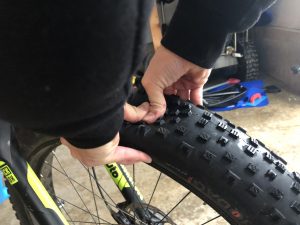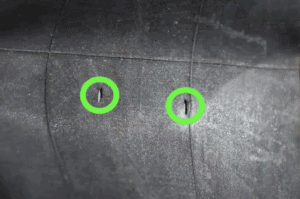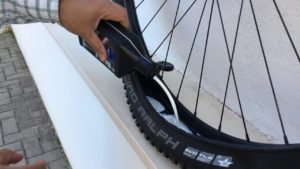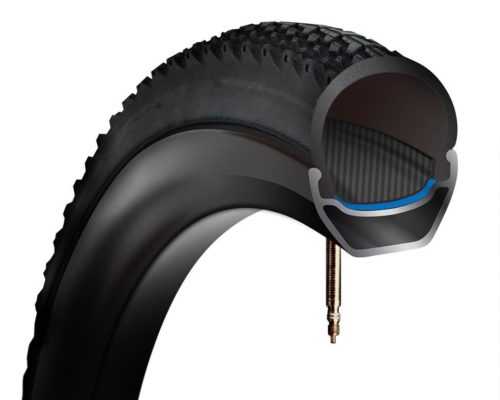Anyone who has done any research on bikes in the last few years has definitely seen manufacturers tout their tubeless-ready tires. This technology is still relatively new, but more and more people are adopting it because of some benefits.
What does tubeless-ready actually mean for bike riders? Instead of assuming that newer means better, we look at the good and the bad of going without a tube inside the tire. This way, people can make the best decision for them currently.
What Does Tubeless-Ready Mean?

To put it simply, tubeless-ready means that the tires are ready to go if a person wants to go with this new way of filling up a tire.
The traditional method of putting a tube inside is still usable, but tubeless-ready means that that tube can be eliminated with the right tires and the right know-how.
Whether or not a person actually wants to go tubeless is another question altogether. Some people believe that it is without a doubt an upgrade, while others think that it might not be such a smart move (or completely unnecessary).
Not sure what to do with tires? The general pros and cons are listed below. From there, we give our recommendation on who can benefit most from tubeless tires, and who might not feel that much of a difference.
What Are The Pros of Tubeless Tires?
Those who are strong proponents of tubeless tires have nothing but great things to say about them in general.
A few pros stand out from the rest, so pay close attention before making an investment. In some cases, a person buying a brand new bike won’t have to pay anything extra for a tubeless-ready tire setup. This makes it even more of a no-brainer to go with it.
Eliminating Pinch Flats
Most of the time, companies use this as a number one selling point for tubeless tires. Without a tube inside, a pinch flat is not possible.
A pinch flat happens when a tire hits something on the ground, and it then deforms in such a way that the inner tube gets squashed up against the rim.
It will usually form a snakebite type of puncture that is hard to patch up and repair while out on a ride. It takes a complete stop for riders, and if they don’t have something to repair it, they could be out of luck.
With a tubeless setup, there’s no inner tube that is in the way. Not only that, but tubeless tires have a sealant already in the tire so that small punctures can be healed. It reduces the risk of a flat tire overall, which is always a positive for riders.
Lower Tire Pressure

A tubeless-ready tire setup allows for lower tire pressure overall. This has many benefits in itself, as lower tire pressure helps smooth out rides, add comfort, and make life easier for a lot of riders.
Lowering the tire pressure might not seem like the best idea with road cycling and going on other flat surfaces. There does need to be some stiffness to the tire so that it performs well.
However, lowering the tire pressure really comes in handy if someone’s riding a mountain bike or a fat bike. Being able to float over harsh surfaces actually makes it faster, despite the thought process that less air would make the bike lag.
Not having any fear of the negatives with low tire pressure definitely makes it beneficial.
Better Puncture Resistance

Since the tubeless-ready tire is a bit thicker and has sealant already in it, it’s going to be better with puncture resistance overall.
That’s great news for riders who may be challenging themselves a bit too much. No, tubeless tires are not indestructible, but they usually last a little bit longer.
That can help offset the cost that goes with investing in the first place. If tubeless tires last up to twice the amount of time as regular tires, they all of a sudden become a great deal.
Better Overall Performance
Most riders will notice that they get a much better performing tire with a tubeless-ready option. That’s because it helps with rolling resistance, stays strong, and is just a more modern type of tire in general.
Companies have to make sure that they put the latest technology onto those tires, and the rim designs are usually a little wider as well.
All of these subtle changes might not seem like much, but they add up to the point that people will notice the change right away.
Having a little bit of a boost with performance can make a big difference. Some people are blown away by just how much of a change it makes to go to a tubeless-ready tire.
What Are The Cons Of Tubeless Tires?
It’s not fair to talk about all the positives of tubeless-ready tires without taking a look at some of the negatives. There’s not a slam dunk decision for a lot of bike owners, but at least having the option to turn to tubeless is pretty nice.
It’s important to note that tubeless-ready tires and rims don’t necessarily mean that a person has to go that route if they don’t want to.
Price
Tubeless-ready tires and rims come at a bit of a premium. That’s to be expected, as they offer a bit more flexibility. There’s also a bit more work that goes into developing these bike tire solutions.
A lot of supporters for tubeless tires justify the cost because, in the long run, it all balances out. With fewer flats, that means more chances to go without having to get a replacement.
Still, it’s a cost that makes a lot of people pause and wonders if they will truly see a difference.
Harder To Fit
For people who like speed when taking tires on and off, choosing tubeless-ready options are going to be a little more frustrating for most.
It’s a little more precise, and it must form a perfect seal so that everything performs exactly as it should.
There are quite a few people who start to get the hang of it and eventually get the time down a bit, but everyone else is pretty much stuck to add more time to their usual routine.
The first thing that’s a little challenging is that it takes a good amount of strength to remove the tire. It’s not as simple as pulling, and even a tool will not be able to make it that much easier.
There are even some people who have to go to a professional in order to replace tires. It is more annoying than anything for the vast majority of riders.
Topping Tires Off

One of the most tedious parts of tubeless tires is that they can lose some air seemingly out of nowhere. They seal up to a certain degree, but they are more prone to losing air pressure throughout a rider.
Sealant in the tubeless-ready tires will start to lose its effectiveness after a few months. It’s recommended that everything is examined once every three months, even if a replacement is not necessary right then and there.
The best way to know if the sealant is not working as well as it should is to check if the bike loses severe air pressure in just a few hours of sitting around.
Are Special Rims Needed For Tubeless Tires?
For the most part, brand new bikes are equipped enough that no special rims are needed. Either the rims already come tubeless-ready, or a person can use a tubeless conversion kit to make the rim as airtight as possible.
It’s important to have a strong seal, so a rim that’s designed for tubeless will definitely make a difference.
The good news is that these rims are stronger and durable than ever. At the very least, having tubeless-ready tires already on a bike means that the rims are ready to take on all sorts of challenges along the way.
What Riders Benefit Most
Riders who get the most amount of benefits from tubeless tires are mountain or fat bike riders. They not only get to have a much more durable wheel overall, but their rides are much more comfortable.
Every single type of bike rider will love having a more durable option, but it’s not like road cyclists are going to drop down in air pressure too much.
After spending so much money on a brand new bike, it’s understandable that people might not want to also spend additional money to upgrade the tires and wheels.
If it already performs well, this upgrade might not be worth it in the end. There’s plenty of people who don’t ride as much, don’t feel the need to go at an insane speed, or just want a bike without much fuss in general. Spending extra on tubeless-ready tires might not make sense to them.
Ultimately, the best advice right now is for people who are shopping for a new bike to shop exclusively for tubeless-ready options.
This way, making the move is easy, and the cost is already built into the new bike. People looking to upgrade their existing bike should weigh the pros and cons for themselves specifically first.

